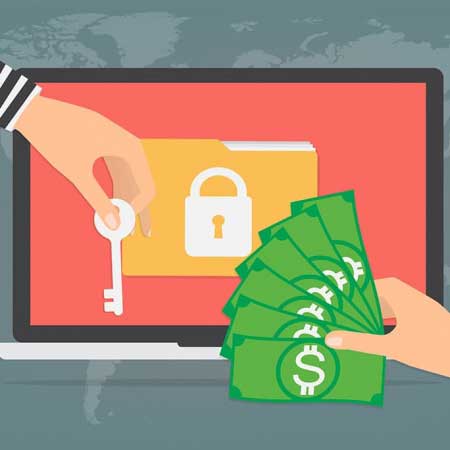TIPS TO PREVENT RANSOMWARE ATTACKS
Learn about your ransomware protection options, with these security tips for businesses.
Learn about your ransomware protection options, with these security tips for businesses.
by Akiva Goldstein | May 15th, 2019

In short, ransomware protection is more critical than ever. Over the past decade, ransomware has evolved considerably to what it is today. Its varieties have grown and advanced in capabilities for spreading, evading detection, encrypting files, and forcing victims to pay hefty ransoms. For example, the first ransomwares would simply encrypt the local hard drive and ask for money. Today, the latest evolutions are encrypting the entire network drives. Without ransomware protection, they are capable of leaking data. As a result, they make the extortion case even worse by threatening to publish the company data publicly.
Ransomware attacks are on the rise year-after-year, with no clear end in sight. According to Cybersecurity Ventures, businesses will fall victim to a ransomware attack every 14 seconds in 2019 and every 11 by 2021. Furthermore, ransomware damage costs are predicted to be 57X more in 2021 than they were in 2015. This makes ransomware the fastest growing type of cybercrime.
Getting caught up in ransomware is a dangerous game for businesses, large and small alike. For example, a virus that lands in a network’s shared locations can block organization’s access to specific files or the entire hard drive, literally paralyzing business functioning. The good news is that most ransomware attacks can be prevented through proactive measures. We can show you how to withstand a malicious virus, detect it, and bounce back as soon as possible, with proper ransomware protection.
Ransomware is a particularly nasty type of malware. Most commonly, it comes in the form of a malicious code designed to make use of system or software vulnerabilities. In many cases, the virus gets into a machine through phishing emails. First, they send an infected attachment such as URGENT ACTION REQUIRED with a file extension of .PDF, .zip or .rar, which slips by the unsuspecting victims. Then it loads harmful malware after being downloaded.
As a result, this attack often encrypts the entire hard disk or some or all of the user’s data and requires a ransom to unlock. In many cases, the victim must pay within a set amount of time, otherwise the access will be lost forever. And of course, since we’re dealing with criminals, paying the ransom doesn’t guarantee the access will be restored at all.
Generally speaking, the best protection is prevention. We have put together best security tips that every business should implement to keep its sensitive data from being held hostage. Another critical method to preventing Ransomware is employee cyber security training.
A good and regular backup system should be in place to enable quick recovery in case of an infection. There are many choices here – you can either set up an automated backup system on the Cloud or just create manual backups on a physical storage device. But the best practice to keep your data safe in almost any failure scenario is following the 3-2-1 rule:
3 – have at least three backup copies of your data
2 – store two backup copies on different devices or storage media
1 – keep at least one backup copy off site
Backing up to offsite will help protect backups from being altered, so that in case ransomware does infect the computer, it won’t be able to touch the backup. Having a good backup is essential line of defense, if you are hit with ransomware, you can recover quickly and not pay the cyber criminals.
In many cases, end-users without the proper education can defeat the best of technical controls. By educating your team about ransomware protection, you will significantly improve the most important level of defense within your organization. Since most ransomware is delivered by spear phishing, it is critical to teach employees how to identify phishing e-mails and not to click on links in these e-mail without knowing they are from a trusted source.
Installing multiple layers of security and ransomware protection can identify and block attacks before they happen. First of all, install a traditional firewall with a virus scanning engine, intrusion prevention, and web content filtering. A firewall will block unauthorized access to your network from the Internet. Couple a firewall with anti-virus and anti-malware applications on the end-user machines and servers. They will prevent, search for, detect, and remove software viruses and other malicious software like worms, trojans, adware and other nasty things
Cybercriminals will typically look for vulnerabilities and misconfigurations that they can exploit to gain access to your network. Ensure that your browsers, OSes and other software applications are regularly updated with the latest security patches. Many ransomware attacks use older versions for which there are security software defenses.
Lastly, if you do fall victim to a ransomware attack, take these important steps to handle it quickly and responsibly.
> Notify customers about a data breach
> Restore personal identities of affected customers
> Recover compromised data
> Repair damaged computer systems
> Help with legal fees and expenses related to the incident
Unfortunately, Ransomware is becoming smarter and more dangerous for businesses. Therefore, companies’ sensitive data must be extremely protected in the era of data breaches and increasing volume of ransomware attacks. Fortunately, you can learn the proper steps for ransomware protection to prevent, detect and recover from ransomware, as well as minimize its impact on your business. Use these tips to keep your data safe and stop a ransomware attack before it starts.
Are you thinking about strengthening your IT security efforts? We’re always happy to help. Feel free to contact us any time at 877-467-4989 or Email us.
